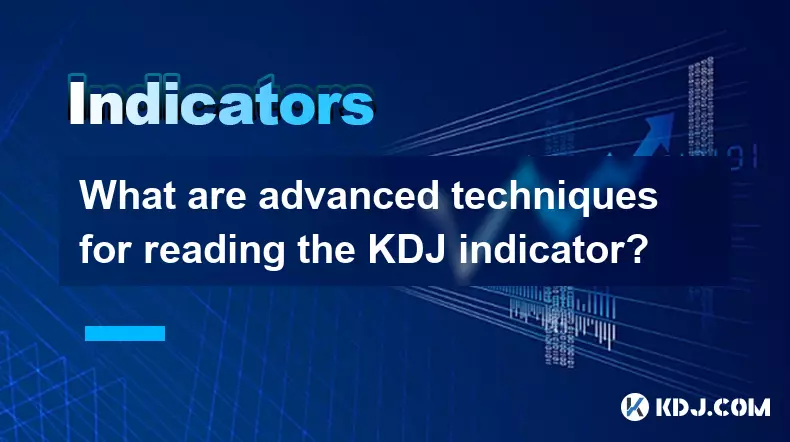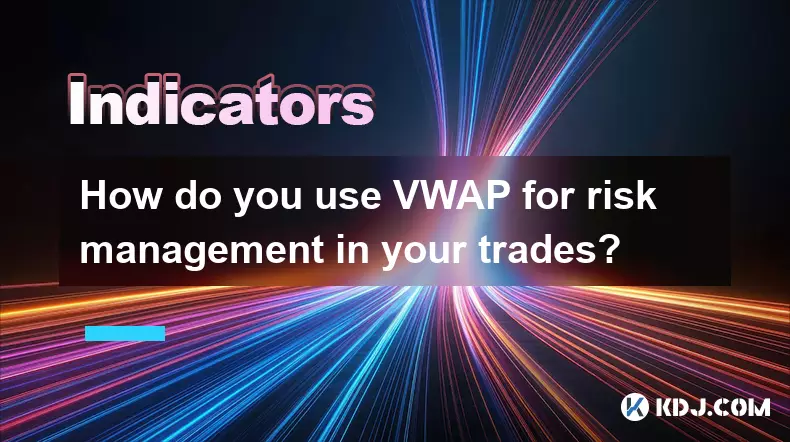-
 bitcoin
bitcoin $114684.631706 USD
-0.87% -
 ethereum
ethereum $4228.677447 USD
1.58% -
 bnb
bnb $1294.880693 USD
-1.16% -
 tether
tether $1.000819 USD
-0.02% -
 xrp
xrp $2.605138 USD
2.79% -
 solana
solana $209.908690 USD
5.89% -
 usd-coin
usd-coin $0.999903 USD
-0.03% -
 dogecoin
dogecoin $0.213423 USD
2.93% -
 tron
tron $0.322721 USD
-0.10% -
 cardano
cardano $0.727247 USD
3.66% -
 hyperliquid
hyperliquid $42.339456 USD
6.05% -
 chainlink
chainlink $19.910811 USD
5.16% -
 ethena-usde
ethena-usde $1.000557 USD
0.00% -
 stellar
stellar $0.349734 USD
2.69% -
 bitcoin-cash
bitcoin-cash $543.848687 USD
-0.21%
What are advanced techniques for reading the KDJ indicator?
The KDJ indicator enhances crypto trading by identifying reversals through divergences, crossovers, and multi-timeframe analysis, especially when combined with volume and trend filters.
Oct 10, 2025 at 10:00 pm

Understanding the KDJ Indicator in Crypto Trading
The KDJ indicator, an extension of the stochastic oscillator, is widely used in cryptocurrency trading to identify potential reversal points and momentum shifts. Unlike traditional indicators that focus solely on price and volume, the KDJ incorporates a dynamic calculation involving the %K, %D, and %J lines, offering deeper insight into market sentiment. Traders who master its advanced applications gain a strategic advantage in volatile digital asset markets.
Interpreting Divergences for Early Reversal Signals
- Bullish divergence occurs when the price makes a lower low while the KDJ forms a higher low, signaling weakening downward momentum in assets like Bitcoin or Ethereum.
- Bearish divergence happens when the price reaches a higher high but the KDJ peaks at a lower level, suggesting exhaustion in upward movement.
- Divergences are especially reliable when they appear near overbought (above 80) or oversold (below 20) zones, increasing the probability of trend reversals.
- Confirming divergences with candlestick patterns such as engulfing formations or hammers improves signal accuracy.
- Using longer timeframes like the 4-hour or daily chart enhances the strength of divergence signals compared to shorter intervals.
Leveraging Crossovers with Confirmation Filters
- A buy signal is generated when the %K line crosses above the %D line in the oversold region, particularly below 20, indicating potential upward momentum.
- A sell signal appears when %K crosses below %D in the overbought zone, typically above 80, hinting at a pullback.
- Blindly following crossovers can lead to false entries; adding volume analysis helps validate whether the move has supporting interest.
- Integrating moving averages ensures trades align with the broader trend—only taking long signals when price is above the 50-period EMA, for example.
- Waiting for the J line to exit extreme zones before acting prevents premature entries during choppy market phases.
Combining KDJ with Multi-Timeframe Analysis
- Analyze the daily KDJ to determine the dominant trend direction before drilling down into the 1-hour or 15-minute charts for precise entry points.
- If the daily KDJ is rising from oversold levels, short-term sell signals on lower timeframes should be treated with caution.
- Aligning KDJ readings across multiple frames increases confidence—for instance, when both 4-hour and daily show bullish crossovers.
- This method reduces noise and filters out countertrend trades that may look attractive in isolation but conflict with macro momentum.
- Traders using this technique often set alerts on higher timeframes to monitor key levels while executing on responsive lower intervals.
Frequently Asked Questions
How does the J line enhance KDJ analysis in fast-moving crypto markets?The J line, being the most sensitive component, reflects acceleration in price momentum. In highly volatile conditions, spikes in the J line beyond 100 or below 0 indicate extreme enthusiasm or panic, often preceding sharp corrections. Monitoring these extremes helps traders anticipate blow-off tops or capitulation bottoms.
Can the KDJ be applied effectively to altcoins with low liquidity?While possible, the KDJ's reliability diminishes in illiquid altcoins due to erratic price swings and manipulation risks. It performs best on major cryptocurrencies with consistent volume. For smaller tokens, combining KDJ with order book depth and funding rate data improves context.
What settings optimize the KDJ for intraday crypto trading?A common configuration for scalping involves a 9-period %K, 3-period %D, and smoothing factor of 3. Adjusting to a 5-3-3 setup increases sensitivity for faster signals. However, tighter parameters require stricter stop-loss placement to manage increased false triggers.
How do funding rates interact with KDJ-generated signals in futures trading?When the KDJ indicates overbought conditions and funding rates turn sharply positive, it suggests leveraged long positions dominate, raising the risk of a liquidation cascade. Conversely, oversold KDJ readings amid negative funding can highlight short squeezes. These confluences refine timing for derivatives entries.
Disclaimer:info@kdj.com
The information provided is not trading advice. kdj.com does not assume any responsibility for any investments made based on the information provided in this article. Cryptocurrencies are highly volatile and it is highly recommended that you invest with caution after thorough research!
If you believe that the content used on this website infringes your copyright, please contact us immediately (info@kdj.com) and we will delete it promptly.
- XRP Price Prediction: Weekend Rollercoaster or Rally?
- 2025-10-12 08:45:16
- Bittensor (TAO): Super Bullish Signals Point to Potential 2x Rally
- 2025-10-11 10:25:12
- Silver Price Correction: Navigating the Dip & Identifying Key SEO Keywords
- 2025-10-11 10:25:12
- Decoding Crypto Trends: Bittensor's Bull Run, Cardano's Dip, and LivLive's Presale Buzz in 'Uptober 2025'
- 2025-10-12 08:45:16
- MoonBull: The Crypto Meme Coin Promising 1000x Gains?
- 2025-10-11 10:30:01
- Crypto Payroll Revolution: Stablecoins, Altcoins, and the Future of Salary Payments
- 2025-10-11 10:30:01
Related knowledge

What's the main difference between VWAP and TWAP?
Oct 12,2025 at 11:54am
Understanding VWAP and Its Role in Crypto Trading1. Volume Weighted Average Price (VWAP) is a trading benchmark that calculates the average price of a...

How do you identify exhaustion moves using VWAP and its bands?
Oct 12,2025 at 08:00am
Understanding the Role of Decentralized Exchanges in Crypto Trading1. Decentralized exchanges (DEXs) operate without a central authority, allowing use...

How do you use VWAP to scale in and out of positions?
Oct 14,2025 at 02:19am
Understanding VWAP as a Dynamic Benchmark1. The Volume Weighted Average Price (VWAP) is not just an indicator—it functions as a dynamic benchmark that...

What are the main advantages of using VWAP over EMA?
Oct 11,2025 at 02:18am
Main Advantages of Using VWAP Over EMA1. Volume-Weighted Average Price (VWAP) incorporates trading volume into its calculation, offering a more accura...

How do you use VWAP on different chart types like Heikin Ashi?
Oct 11,2025 at 05:01pm
Understanding VWAP in the Context of Heikin Ashi Charts1. The Volume Weighted Average Price (VWAP) is a powerful analytical tool commonly used by trad...

How do you use VWAP for risk management in your trades?
Oct 11,2025 at 02:54am
Understanding VWAP as a Dynamic Benchmark1. The Volume Weighted Average Price (VWAP) serves as a crucial reference point in intraday trading by reflec...

What's the main difference between VWAP and TWAP?
Oct 12,2025 at 11:54am
Understanding VWAP and Its Role in Crypto Trading1. Volume Weighted Average Price (VWAP) is a trading benchmark that calculates the average price of a...

How do you identify exhaustion moves using VWAP and its bands?
Oct 12,2025 at 08:00am
Understanding the Role of Decentralized Exchanges in Crypto Trading1. Decentralized exchanges (DEXs) operate without a central authority, allowing use...

How do you use VWAP to scale in and out of positions?
Oct 14,2025 at 02:19am
Understanding VWAP as a Dynamic Benchmark1. The Volume Weighted Average Price (VWAP) is not just an indicator—it functions as a dynamic benchmark that...

What are the main advantages of using VWAP over EMA?
Oct 11,2025 at 02:18am
Main Advantages of Using VWAP Over EMA1. Volume-Weighted Average Price (VWAP) incorporates trading volume into its calculation, offering a more accura...

How do you use VWAP on different chart types like Heikin Ashi?
Oct 11,2025 at 05:01pm
Understanding VWAP in the Context of Heikin Ashi Charts1. The Volume Weighted Average Price (VWAP) is a powerful analytical tool commonly used by trad...

How do you use VWAP for risk management in your trades?
Oct 11,2025 at 02:54am
Understanding VWAP as a Dynamic Benchmark1. The Volume Weighted Average Price (VWAP) serves as a crucial reference point in intraday trading by reflec...
See all articles










































































